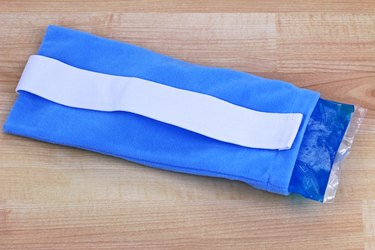
A tight lower back could be a signal that something's missing in your running routine.
Because the human spine never seemed to totally agree with the whole bi-pedal thing, the act of running requires correct preparation and cool-down to keep the body in balance. Otherwise, you're likely to experience consequences, such as tightness in the lower back. And that's a precursor to inflammation and most likely pain.
Video of the Day
Video of the Day
Here's a look at both preventive and palliative measures for runners to take when the lower back muscles start to retract and rebel.
Read More: Lower Back Muscle Pain from Running
Always Warm Up
Muscles are at their best when well-supplied with blood and oxygen. This takes a little time to happen, so before breaking into a full run, be sure to ease in gradually.
Keeping your pace to a brisk walk or an easy jog for five or 10 minutes will prepare your muscles for action and allow them to lengthen gradually. This reduces the chances of them drawing up even more or going into spasm in response to sudden stress.
The best warm-up begins with a 10-minute low-intensity jaunt followed by some dynamic stretches (i.e., butt kickers, lunges and squats.) Cool down in a similar fashion, allowing the blood to gradually gather back to your core from your limbs.
Yoga for Stretching...
Although static stretches aren't particularly helpful before an actual run, keeping your hamstrings, obliques and glutes gently elongated will do much to keep your lower back free and easy. Doing them after a run is helpful, and so is doing them on your non-running days, after a gentle warm-up.
When the hamstrings are uptight, the pelvis goes out of alignment, sometimes putting pressure on root nerves around the lumbar disks. Yoga is a superb antidote to this tendency.
Simple forward bend poses, whether sitting or standing, will help this correct itself. Fire Log pose helps sooth the savage piriformis muscle, one of the main causes of sciatic pain. And don't under estimate the the power of the good old Downward-Facing Dog, which loosens the hamstrings and also stretches the erector spinae muscles that flank either side of the length of the spine.
...and Core Strength
Your core muscles play a key role in your lower back's mobility, as well as your balance and your gait. Exercising the transverse abdominus, which is the deepest-lying abdominal muscle, can improve lower back pain and increase mobility. One of the best ways to do that: Plank pose. To do Plank, get into the top of a push-up and hold for 30 to 90 seconds.
This, however, doesn't let you off the hook for doing those crunches, which even for yoga practitioners and certainly for runners are fairly non-negotiable.

Rescue Tactics
Tightness in your lower back is also a sign that you're over-training. First step: back off for a couple of days, or until you feel you're out of the danger zone.
If the discomfort prevents you from sitting or lying down comfortably, you make want to take some palliative measures. A heating pad applied to the tight area increases blood flow to the over-tight muscles and helps them relax. Some chiropractors recommend alternating heat with cold packs to shock the muscles out of spasm.
Some over-the-counter pain relievers could be more helpful than others. Tylenol might reduce pain but it won't do anything for inflammation. Non-steroidal anti-inflammatories (NSAIDs) such as ibuprofen or naproxen, however, actually put you on the road to healing by reducing inflammation.
Read More: Is Running Good or Bad for Back Pain